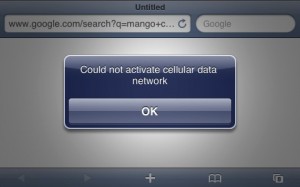The excitement of mobile computing suggests a utopia with always-on cloud connections, and apps that don’t need to function offline.
I spend a lot of time in the Bay Area, where a lot of smartphone hardware and apps are designed and built. My perception is that wireless data connections there are much better. People there also have less appreciation for how bad things are in places like…New York City.

I live in the New York City suburbs and commute daily into Manhattan. That includes trains and walking, both above and below ground, around buildings, people and trees. If there’s one thing my commute proves, it’s that wireless data service in New York is not good enough to support the most important apps on my smartphone.
The spotty data service around New York’s geographic nooks and crannies affects not only standard voice-call quality, but makes key services unusable, like most news readers, streaming music players (Songza and TuneIn), fitness trackers (Fitbit), and voice and texting applications (Google Voice). The connection quality also severely erodes the experience of social networking and email apps (Gmail).
On a related note, I use the Pulse newsreader because it has a good offline reading capability. Many online publishers offer only partial news feeds — a short summary with a link to the full story on the website. They do this in order to drive page views for advertising. The problem: no mobile data connection, no story. That’s one reason why I love — and read much more — quality business and tech news sites that offer full RSS feeds, like WSJ’s CMO Today and Re/Code.
Finally, sporadic wireless data service can make your smartphone deplete its battery faster, and even more so when you’re attempting to use apps that require data connections. All the more reason for me to just give up on using my smartphone during commutes.
Until wireless data service becomes more reliable and ubiquitous, smartphone manufacturers and app developers must design better for offline use cases. Smartphones and apps need to do a better job of anticipating data and content requests; fetching, storing and buffering; and creating interface and user experiences that make the best of sporadic connections and data time-outs.
Thankfully, my Kindle works great. I use the Push To Kindle app, which lets you send web articles from your desktop computer or smartphone to your Kindle app or device for offline reading.
Happy reading.
Photo: Dave Bledsoe

